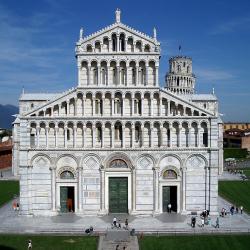The work and methodology

-
Methodology
The work carried out was set up with the aim of reaching a complete, clear, flexible Management Plan, with the aim of being the fundamental strategic and operational reference for the conservation, management, and enhancement of Piazza del Duomo in Pisa. The Plan represents the set of values, vision, mission, and objectives, shared by all those involved in the protection and management of the Site.
The scope of the Plan is represented by the area registered in the WHL, or core area (as explained in Section 2.2.2 of this document). However, some components of the Plan, whether they relate to the analysis or the actual design, cannot ignore considerations about a larger area, typically coinciding with its "buffer zone" of the Site (Section 2.2.2).
The structure of the document articulates the three macro-phases that led to the development of the Plan: analysis, design and planning of actions and tools for its implementation.
- The analysis aims at a shared overall understanding of the Site, of its distinctive characteristics relative to its Outstanding Universal Value, of dynamics and pressure factors that support or threaten the conservation of the Site, and other favorable or critical aspects related to its management. In particular, the Plan focuses on the analysis of the criticalities that emerged from the official documents produced by the World Heritage Center, as well as on what emerged from ad environmental surveys conducted in preparation for the subsequent design phase.
- The planning phase concerns the definition of the strategy and to structuring feasible and targeted actions for the pursuit of the Plan’s mission. Specifically, the Action Plan outlines operational strategies and projects to be implemented in the medium term.
- Implementation relates to the creation of tools and operating methods that support the success of the provisions of the Plan, such as governance and management coordination mechanisms as well as tools for monitoring projects and actions.
The 5 Strategic Objectives of the Convention, known as the "5Cs", which guided the World Heritage Center in drafting the Operational Guidelines since the 2002 Budapest Declaration, constitute the areas of intervention of the Plan.
The Action Plan consists of a series of projects and interventions to be implemented to achieve the objectives of the Management Plan, by clearly defining for each of these the goals, the individuals and entities involved, timing, and the related necessary resources.
Each intervention is designed in response to criticalities identified in the previous chapter and reported, according to the classification in thematic areas, in the synoptic framework of Section 3.3 of the report. Each of them responds to at least one of the five Strategic Objectives. Additionally, it is not excluded that the planned activities and the expected results may also intervene in reference to other axes, as shown in the table on the following page, and may anticipates the project sheets developed for the Action Plan.
Furthermore, each action was designed for the pursuit of sustainability objectives, taking as a reference the Sustainable Development Goals (SDG) developed by the U.N. as part of the 2030 Agenda for sustainable development. Overall, 17 SDGs have been identified, divided into 169 targets and over 240 indicators. The SDGs system is transversal: it can be applied to any area or sector, as it is believed that the assessment of the contribution to the achievement of the objectives of the 2030 Agenda is measurable through a selection of the most appropriate targets and indicators for context of reference.
